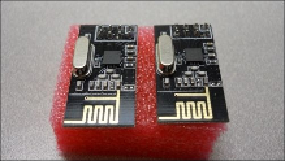Hardware Reference
In-Depth Information
Connecting a simple RF interface to
Arduino
Let's start by connecting to Arduino with a simple RF interface. For this exercise, it will be
easiest if you connect your development machine to Arduino with an RF interface and then
connect to another Arduino with a similar RF transceiver. There are some very inexpensive
and watch what frequency your devices use, as they may violate your country's frequency
usage rules. Each country regulates who can use what frequencies. For more information,
visit
www.wired.com/2010/09/wireless-explainer/
. For example, 433 MHz is fine for
Europe, but can't be used in the US unless you have the proper amateur radio license. 915
MHz is available in the US but not in Europe. 2.4 GHz is fine in either case, so you might
want to go with a transceiver that operates at 2.4 GHz.
The following is an image of a 2.4 GHz device, which is the nRF24L01+ 2.4 GHz wireless
transceiver, available at many online retailers, including
amazon.com
:
You will want to purchase two of these devices. Initially, to try the example, connect each
of the pair to your Arduino. You will also need to connect each device to a host computer
so that you can monitor the
Serial Monitor
port. Eventually, when you have the system up
and working, disconnect one of the devices from the host computer and connect it to a bat-
tery so that it can run without a host connection. To connect the devices to Arduino, con-
nect to the pins on the back of the device. The following is an image of the connections on
the back of the device:

